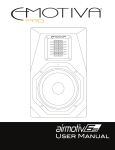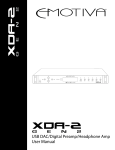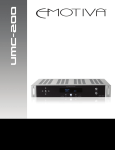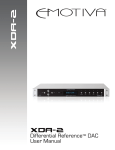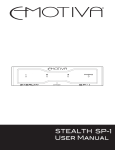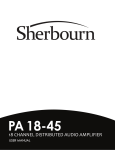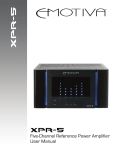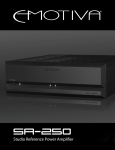Download Emotiva XSP-1 Specifications
Transcript
Important Safety Precautions and Explanation of Symbols ! The exclamation point within an equilateral triangle is intended to alert the user to the presence of important installation, operation, and service instructions in this manual. The lightning flash with arrowhead symbol within an equilateral triangle is intended to alert the user to the presence of uninsulated dangerous voltages within the enclosure that may be of sufficient magnitude to constitute a risk of electrical shock to the user. Please read this Manual thoroughly before attempting to install, configure, or operate the XSP-1 Stereo Preamplifier. After successful installation and configuration of the XSP1-, be sure to retain this manual in a safe place for future reference. Safety is a key component to a long lasting and trouble free installation. Please read and follow all instructions and heed all warnings on the XSP-1 and in this manual. The vast majority of the subsequent safety precautions are common sense. If you are not comfortable with the installation of audio/video entertainment equipment, you should seek the services of a qualified installation professional or call us for help. ! WARNING: TO REDUCE THE RISK OF FIRE OR ELECTRIC SHOCK, DO NOT USE THE XSP-1 NEAR WATER OR IN WET LOCATIONS, DO NOT EXPOSE IT TO RAIN OR MOISTURE, DO NOT EXPOSE IT TO DRIPPING OR SPLASHING FROM OTHER SOURCES, AND ENSURE THAT NO OBJECTS FILLED WITH LIQUIDS (SUCH AS VASES) ARE PLACED ON IT. DOING SO MAY RESULT IN DAMAGE TO THE UNIT AND THE RISK OF ELECTRIC SHOCK, WHICH MAY RESULT IN BODILY INJURY OR DEATH. WARNING: TO REDUCE THE RISK OF ELECTRIC SHOCK, DO NOT REMOVE THE COVER FROM THE XSP-1. THERE ARE NO USER-SERVICEABLE PARTS INSIDE THE UNIT. REFER ALL SERVICE TO QUALIFIED SERVICE PERSONNEL. Do not install the XSP-1 near or above any heat sources such as radiators, heating vents, or other apparatus that produces heat. Do not block any ventilation openings or heat sinks. Avoid installing the unit directly above other heat-producing equipment unless sufficient ventilation or forced-air cooling is provided. Do not install the XSP-1 in locations without proper ventilation. The XSP-1 should not be operated on a bed, sofa, rug, or similar surface that may block vents. The unit should not be installed in an enclosed location such as a bookcase, cabinet, or closed equipment rack unless sufficient forced-air ventilation is provided. Always install your XSP-1 according to the manufacturer’s instructions and only use attachments or accessories specified by the manufacturer. Do not install the XSP-1 on any stand, shelf, or other piece of furniture that is unable to support its weight. If a cart is used to move the unit, use caution to avoid injury from tip-over. Connect the XSP-1 only to power sources of the correct voltage (as shown in this manual and on the XSP-1 unit). Protect power supply cables from being pinched, walked on, or otherwise damaged. Be especially careful where the power cable enters the power outlet and the unit. Only connect the XSP-1 to an electrical outlet or extension cord of appropriate type and rating. DO NOT defeat the safety purpose of a grounding or polarized plug by removing ground pins or using unsafe adapters. A polarized plug has two blades - one wider than the other. A grounding plug has a third ground prong in addition to the two main conductors. The wide blade or third groundling prong is provided for your safety. If the provided plug does not fit your outlet, consult an electrician to replace your obsolete outlet. If you replace the power cord, only use one of similar type and equal or greater current rating. The power cable for the XSP-1 should be unplugged from the outlet during severe electrical storms, or when unused for a long period of time. Only replace the fuse(s) in the XSP-1 with fuse(s) of proper value and voltage rating. The XSP-1 should only be cleaned as directed in the Manual. Avoid spraying liquids directly onto the unit and NEVER spray liquids into the vents. Care should be taken so that small objects do not fall into the inside of the unit. ! You should seek service for your XSP-1 by qualified service personnel if any of the following occur: 1. The power-supply cord or the plug has been damaged. 2. Objects or liquid have fallen or spilled into the vents. 3. The unit has been exposed to rain. 4. The unit exhibits a marked change in performance. 5. The unit has been dropped, or its enclosure or chassis is damaged. NOTE: TO COMPLETELY DISCONNECT THE XSP-1 FROM THE AC POWER MAINS, DISCONNECT THE AC POWER CORD FROM THE AC RECEPTACLE. NOTE: THE POWER CORD ON THE XSP-1 MUST REMAIN READILY ACCESSIBLE AT ALL TIMES. CAUTION CAUTION: TO REDUCE THE RISK OF ELECTRICAL SHOCK, DO NOT REMOVE COVER. NO USER SERVICEABLE PARTS INSIDE. REFER SERVICING TO QUALIFIED SERVICE PERSONNEL. XSP-1 XSP-1 Differential Reference Stereo Preamplifier Contents Important Safety Precautions and Explanation of Symbols XSP-1 Differential reference Stereo Preamplifier................................1 Introduction..........................................................................................3 About This Manual...............................................................................4 Features..............................................................................................5 Unpacking...........................................................................................6 XSP-1 Front Panel..............................................................................7 XSP-1 Rear Panel.............................................................................10 Quick Start.........................................................................................15 Connections......................................................................................16 Configuration and Operation.............................................................19 Care and Maintenance......................................................................22 Specifications....................................................................................23 Troubleshooting.................................................................................27 Emotiva Audio Corporation Five-Year Limited Warranty...................28 Notes.................................................................................................30 Page 1 XSP-1 Page 2 XSP-1 Introduction Thank you for purchasing your new XSP-1 Differential Reference stereo preamplifier. The XSP-1 is the result of a two-year development effort aimed at creating a reference-caliber, fully balanced, analog stereo preamplifier. The XSP-1 Differential Reference preamplifier offers the ultimate in sound quality and control for audiophiles who are searching for the finest possible stereo listening experience. The XSP-1 gives you the best of both worlds by combining the superb sound quality of a completely analog signal path, fully differential from end to end, with the control, ease of use, and repeatability of a digitally controlled component. Input selection is via instrumentation-grade relays with silver clad contacts; and system level control is achieved via a high performance, digitally controlled, analog resistor ladder network in order to maintain pure analog sound with near perfect channel matching and repeatability. Overall, the XSP-1 is built with the finest quality passive components and hand selected semiconductors to deliver the highest possible level of performance. Unlike many other preamps these days, the XSP-1 includes a truly stunning phono preamp section, with inputs for both moving magnet and moving coil cartridges (with selectable loading). Other unique features include built-in analog bass management, an external processor loop (tape monitor), trigger inputs and outputs, and a full-function remote control. The XSP-1 is so sophisticated, it even remembers your headphone and main level settings independently. Finally, since most audiophiles have no need for conventional tone controls, we’ve included precision trim controls that allow you to adjust the high-frequency and low-frequency response of your system by a few critical dB to compensate for source material aberrations. We believe the XSP-1 offers the perfect synergy of high performance, pure analog signal handling with digital control, accuracy, and convenience. Prepare yourself for a new level of transparency and sonic beauty. Happy listening! The Emotiva Team Page 3 XSP-1 About This Manual This manual will provide you with the information you need to get started enjoying your XSP-1 stereo preamplifier. For more information about the XSP-1 and our other products, please visit our website at www.emotiva.com. We suggest that you read through the entire manual; we kept things as short and direct as possible. Even if you’re an expert user, you will probably find some interesting information and useful suggestions. You may wish to keep a copy of this manual with your records, and record serial numbers or other purchase information on the Notes page at the back. Page 4 XSP-1 Features The XSP-1 is an audiophile quality analog stereo preamplifier that combines superb sound quality, advanced features, and outstanding value. The XSP-1 is a dedicated analog stereo preamp, with a fully differential all-analog signal path, a very high quality phono preamp (which supports both moving magnet and moving coil cartridges), and an excellent sounding headphone amplifier. The pure analog signal path in the XSP-1 is complemented by the convenience and precision of digital control. Output level on the XSP-1 is set via a precision digital encoder, which instructs a digitally controlled analog resistor ladder network, and which provides near-perfect channel matching and absolute repeatability. With the XSP-1, the volume on your speakers and headphones can be set independently, and the XSP-1 remembers both settings, even when you turn it off. Features offered by the XSP-1 include: • • • • • • • • • • • • Superb sound - via an all-analog signal path. Main output and headphone levels are controlled via a digitally controlled analog resistor network; inputs are switched using relays with silver clad contacts; HF and LF trims are adjusted using digitally controlled discrete analog R/C networks. Differential Reference™ mode - provides a fully differential signal path, from balanced inputs to balanced outputs. Analog bass management - offers a choice of a full range output or separate highfrequency and low-frequency outputs, with independently configurable crossover points. An audiophile grade phono preamp - which supports both moving coil and moving magnet cartridges. Digital convenience - Including the ability to independently set (and store) speaker and headphone volume, a smart mute function, a full-function remote control, and even an option to limit the maximum level at turn-on. Plenty of inputs - four sets of unbalanced line inputs, two sets of balanced line inputs, a separate set of home theater inputs, and a set of phono inputs. A real processor loop - for connecting a recorder or other external processor. Top quality parts and construction - for years of reliable service. Informative front panel display (VFD) - continuously displays the input selected, the volume, and other important status information. Flexible control options - trigger input and output to coordinate turn on/off with other trigger-enabled equipment; IR input for a remote IR sensor, and an IR output. Universal AC line voltage operation - automatic 115 VAC or 230 VAC operation. Fully transferable five-year warranty - ensures that you’ll be able to enjoy your XSP-1 for years to come. You can find more information about the Emotiva XSP-1 on our website at www.emotiva.com. Page 5 XSP-1 Unpacking Your XSP-1 was carefully packed and should reach you in perfect condition. If you notice any shipping damage or other issues when you unpack it, please contact Emotiva immediately. Gently remove your XSP-1 from the packing carton and remove all wrappings and shipping material. It is important to save the box and all packing materials in case your preamp ever needs to be moved or shipped back to the factory for service. We truly value customer feedback and would like to hear from you. Page 6 XSP-1 XSP-1 Front Panel 1 23 HT BYPASS 5 4 6 PROC LOOP VOLUME DIM DIRECT HF BOOST PHONO LF TRIM INPUT1 INPUT2 INPUT3 INPUT4 BAL1 BAL2 CUT MUTE PHONES XSP-1 STANDBY 7 8 9 10 11 12 1. Dim Button Dims the illumination on the VFD (vacuum fluorescent display) and the halo illumination on the front panel buttons and Volume Control; there are ten brightness levels and the brightness increases each time the button is pressed (when you are at brightness 10 and press the button, it drops back to 1). 2. Home Theater Bypass Button When you press this button, the source connected to the Home Theater Inputs is routed directly to the Main Outputs on the XSP-1, bypassing all controls including the level control and bass management. The display will indicate Home Theater Bypass when this is active. (Conversion between balanced and unbalanced is still performed, and the XSP-1 must be On in order for the outputs to be active.) 3. Processor Loop Button Signal from the selected input is always routed to the Processor Loop Output. When the Processor Loop button is pressed, the XSP-1 takes its input from the Processor Loop Input instead of directly from the input source; the VFD shows PrON or PrOff to indicate status. (This is the functionality that used to be called “a tape monitor”, and is used to connect an external sound processor or decoder. The Processor Loop Input can also be used as another line input if desired.) Page 7 XSP-1 4. Direct Button Press this button to bypass the high-frequency and low-frequency trim circuitry; the status will be indicated in the VFD. Unlike old-style tone controls or digital processing, the HF and LF Trim adjustments on the XSP-1 are implemented by discrete analog components, and switched by analog switches under digital control. This yields precise control, perfect repeatability, and the assurance that the trim circuitry is totally out-of-circuit when it is bypassed, while keeping the audio signal entirely in the analog domain. Note: If the Processor Loop is On, and the Direct button is pressed, the VFD will momentarily display the Trim status and then return to displaying the Processor Loop status. 5. VFD (vacuum fluorescent display) The VFD displays all status on the XSP-1, including level, Trim status, and the input that is selected. The VFD brightness can be adjusted in ten levels (using the Dim Button). 6. Volume Knob Rotate the Volume knob clockwise to turn the Volume up; counter-clockwise to turn the Volume down. When there are no headphones plugged in, the Volume knob controls the main output level; when headphones are plugged in, the Volume knob controls the headphone volume; the XSP-1 remembers both separately. When you put the XSP-1 in Standby mode or turn it Off, it will return to the previous Volume setting the next time it is turned On. Level control is via a digitally controlled analog resistor ladder network, which offers true analog sound and near perfect channel matching and repeatability. Note: The Volume knob on the XSP-1 is a digital encoder which instructs the processor to increase or decrease the actual setting of the level control. The VFD indicates the precise setting at any moment, the position of the knob itself does not. 7, 9. HF and LF Trim Controls Note: The Trim feature and the Trim controls only operate when enabled using the Direct function (Direct Off). Both the mode (On or Off), and the settings themselves, are retained when the XSP-1 is put into Standby or powered down. To operate the Trim Controls, press HF or LF to view the current setting; the display will return to normal after a few seconds. While the setting is visible on the display, use the Boost and Cut buttons to raise or lower the level. High-frequencies and low-frequencies can each be individually boost or cut by up to +/- 3 dB (in 1 dB increments). 8. Phones Jack A high-quality headphone amplifier which will provide excellent sound with both high and low impedance headphones. Page 8 XSP-1 10. Standby Button Press to switch the amplifier On; press again to return to Standby. The halo around the Standby Button is lit amber in Standby mode and Blue when the XSP-1 is On. 11. Input Selector Buttons Pressing each button selects the associated Input; the VFD indicates which Input is currently selected. When you put the XSP-1 in Standby or turn it Off, it remembers which Input is selected and returns to it when turned On. 12. Mute Button Press the Mute button once to mute the output of the XSP-1; press it again to return to the previously selected level. Pressing the Mute button mutes both the main outputs and the headphone outputs. Turning the Volume up immediately cancels the mute function. Note: If you turn the Volume down while the XSP-1 is in Mute mode, when the mute function is cancelled the XSP-1 will return at the new (lower) Volume level. Turning the Volume up while the XSP-1 is in Mute mode immediately cancels the mute function. ** Max Start-up Volume Normally, the Volume setting on the XSP-1 is retained when you switch to Standby mode or power the XSP-1 Off (separately for main output and headphone levels), and is restored when the XSP-1 is turned back on (the level actually quickly ramps up to the previously set level.) You can use the Max Start-up Volume feature to limit the level to which the XSP-1 ramps on startup. To activate this feature, press and hold the Mute button for about five seconds. The VFD will change to Max Start-up Volume; use the Volume knob to change the setting and press the Mute button again to accept the setting. (As with other level settings, the Max Start-up Volume settings for the main outputs and for the headphones are stored separately. If you set this without headphones plugged in, it will apply to the main output level; if you set it while headphones are plugged in, it will apply to headphone level.) Note: This setting does NOT limit the maximum level you can set using the Volume knob. When the XSP-1 is turned On, it will normally ramp up to the level that was set when it was turned Off; if the Max Start-up Volume is set to a lower value, the ramping up of the XSP-1’s Volume level at startup will stop at that setting instead. ** Remote Control The buttons on the full function remote control duplicate the functions of the all of the buttons on the front panel of the XSP-1. Page 9 XSP-1 XSP-1 Rear Panel 2 3 4 5 INPUTS 6 7 IMPEDANCE PROC LOOP INPUT 4 LINE OUTPUTS CROSSOVERS IN OUT PHONO GROUND MC MM FULL RANGE HIGH PASS LOW PASS FULL RANGE 230v 1 INPUT 2 BALANCED 1 BALANCED 2 OUT TRIGGER PHONO RIGHT INPUT 1 13 IR IN 1K 470 100 47 LEFT INPUT 3 9 10 11 12 8 HOME THEATER INPUTS MAIN OUTPUTS POWER 115v SUB WOOFER 14 15 POWER LEFT RIGHT LEFT RIGHT LEFT RIGHT SUB LEFT 16 RIGHT LEFT 17 RIGHT 18 SUMMED 19 20 1. Balanced 1 and Balanced 2 (balanced inputs) Balanced inputs. Balanced inputs accept up to approximately 6V RMS. Inputs are selected using the front panel Input Selector buttons or the remote control. 2. Input 1 through Input 4 (unbalanced inputs) Unbalanced inputs. The plastic inserts and washers are color coded: white for left; red for right (left inputs are towards the top). Unbalanced inputs accept up to approximately 3V RMS. Inputs are selected using the front panel Input Selector buttons or the remote control. 3. Processor Loop Input (unbalanced) If an external processor is connected to the Processor Loop output, the return signal should be connected to this input. If no external processor is connected, this input can be used as an additional unbalanced input. 4. Processor Loop Output (unbalanced) This output provides a copy of the signal received on the selected input of the XSP-1. The Processor Loop is equivalent to what used to commonly be called a “tape monitor”. It is typically used to connect an external processor that is used to modify the signal after the preamp selects it and return the result to the preamp (such as a dedicated speaker equalizer or graphic equalizer). Page 10 XSP-1 5. Phono Ground The Phono Ground is typically used to provide a clean solid ground for a turntable (if it comes with a ground lead), but may also be used to ground the XSP-1 chassis to other equipment as well. 6. Phono Input This input is used to connect a turntable using a Moving Coil (MC) or Moving Magnet cartridge. This input includes the extra gain and RIAA equalization required for a phono cartridge and cannot be used for line level inputs. Most external phono preamps output a line level signal, which must be connected to one of the other inputs on the XSP-1. (If in doubt, please contact Emotiva Tech Support or the makers of your phono preamp.) 7. (MC) Impedance Selector Allows you to select different load impedances when using a moving coil phono cartridge. This switch is only active when the Moving Coil input is selected. Consult the maker of your cartridge for suggestions about choosing the proper setting; or simply choose the one that sounds best. 8. Moving Coil (MC) / Moving Magnet (MM) Cartridge Selector Selects the gain appropriate for either a Moving Coil (MC) or Moving Magnet (MM) type phono cartridge. Moving Coil cartridges usually have much lower output, and require much higher gain, than Moving Magnet types. (There are, however, some Moving Coil units that have higher output and are intended to be treated as Moving Magnet cartridges. There are also passive transformers available , which connect between the cartridge and the preamp, and which raise the output of a MC cartridge to MM levels.) If in doubt, consult the maker of your cartridge or transformer for more information. Note: Connecting a MC cartridge with the switch set to MM will generally result in very low (insufficient) output and excess noise; connecting a MM cartridge with the switch set to MC will usually result in overloading and distortion; neither is recommended. 9. Full Range / High Pass Selector (for Main Outputs) To make the Main Outputs of the XSP-1 full range (and disable bass management for the Main Outputs), set this switch to the left (away from the High Pass adjustment screw). Setting this switch to the right (towards the adjustment screw) enables bass management for the Main Outputs. When bass management is enabled, the Main Outputs carry only the high frequency part of the audio spectrum (the crossover point is set using the High Pass adjustment (10)). When the HT Bypass (Home Theater Bypass) mode is enabled, bass management is entirely bypassed, and the Main Outputs carry a buffered copy of the signal being received at the Home Theater Left and Right Inputs. Page 11 XSP-1 10. High Pass Crossover Frequency Adjustment Adjusts the cut-off frequency for the High Pass filter on the Main Outputs. Fully counterclockwise corresponds to 50 Hz; fully clockwise corresponds to 250 Hz. 11. Low Pass Crossover Frequency Adjustment Adjusts the cut-off frequency for the Low Pass filter on the Subwoofer Outputs. Fully counter-clockwise corresponds to 50 Hz; fully clockwise corresponds to 250 Hz. Note: Combining the bass management on the XSP-1 with other bass management (like the crossover settings on some subwoofers) is usually not recommended. If you’re using the bass management on the XSP-1, you will usually get the best results by setting your subwoofer to “flat” or “direct” if possible. 12. Full Range / Low Pass Selector (for Subwoofer Outputs) To make the Subwoofer Outputs of the XSP-1 full range (and disable bass management for the Subwoofer Outputs), set this switch to the right (away from the Low Pass adjustment screw). Setting this switch to the left (towards the adjustment screw) enables bass management for the Subwoofer Outputs. When bass management is enabled, the Subwoofer Outputs carry only the low frequency part of the audio spectrum (the crossover point is set using the Low Pass adjustment (11)). The Subwoofer Summed Output provides a signal that is a sum of the Left and Right Subwoofer Outputs, and is appropriate for use with a single subwoofer. Some subwoofers include internal (and non-defeatable) bass management, and so work best with a full range signal for their input. When the HT Bypass (Home Theater Bypass) mode is enabled, all three of the Subwoofer Outputs carry buffered copies of the signal received at the Home Theater Sub Input (the signal is reduced by 3 dB on the Left and Right Outputs). Note: To set the XSP-1 for “full bass management”, set both switches towards the center (towards each other). Note: The High Pass and Low Pass crossover points are typically set to the same frequency for smoothest blending of high and low frequency bands, but this may not be optimum in all systems. 13. IR In and IR Out The IR Input is used to allow IR control of the XSP-1 even if it’s located inside a cabinet or in another room, and accepts the output of most standard IR receiver modules. The IR Output repeats the signal received by the IR Input (and the receiver on the front panel of the XSP-1), and so can be used to “repeat” an IR control signal to other components within range of the XSP-1. Page 12 XSP-1 14. Trigger In and Trigger Out The Trigger Input accepts a standard trigger signal to allow the XSP-1 to be turned on (from Standby) by other equipment. The Trigger Output sends out a standard 12 VDC trigger signal which can be used to turn on other equipment (the Trigger Output is active only when the XSP-1 is On). 15. Power (AC Line) Voltage Indicators The XSP-1 automatically detects the proper operating voltage; these indicators show what line voltage was recognized. 16. Home Theater Inputs Balanced and unbalanced inputs. Connect either balanced or unbalanced line level outputs from your home theater preamp / processor or receiver to these inputs. DO NOT connect the speaker level outputs from a home theater receiver to these inputs. When the HT Bypass Input is selected, signal from the Home Theater Left and Right Inputs is routed directly to the Main Outputs, and signal from the Home Theater Sub Input is routed directly to the Subwoofer Outputs. Note: In HT Bypass mode, ALL controls on the XSP-1 are bypassed, including the Volume control and all bass management functions. Note: There is only one set of Home Theater Inputs; both balanced and unbalanced input connections are offered for flexibility. 17. Main Outputs Connect these outputs to the power amplifier(s) used to run your left and right channel main speakers. Both balanced and unbalanced outputs carry the same signal. When the High Pass Selector Switch is set to Full Range, these outputs will carry a full range audio signal; when the switch is set to High Pass, they will carry only the range of audio frequencies above the crossover point set by the High Pass Crossover Frequency adjustment. Both balanced and unbalanced outputs are active at all times. When HT Bypass mode is engaged, the Main Outputs carry a buffered version of the signal present at the Home Theater Left and Right Inputs, and all controls on the XSP-1 are bypassed, including bass management (if otherwise enabled). Page 13 XSP-1 18. Subwoofer Outputs Connect these outputs to the input of your powered subwoofer(s) or to the input of the power amplifier that runs your subwoofer. Both balanced and unbalanced outputs carry the same signal. If you use a single subwoofer, use the Subwoofer Summed Output; if you use two subwoofers in stereo, then use the Subwoofer Left and Right Outputs. When the Low Pass Selector Switch is set to Full Range, these outputs will carry a full range audio signal; when the switch is set to Low Pass, they will carry only the range of audio frequencies below the crossover point set by the Low Pass Crossover Frequency adjustment. Both balanced and unbalanced outputs are active at all times. When the HT Bypass (Home Theater Bypass) mode is enabled, all three of the Subwoofer Outputs carry buffered copies of the signal received at the Home Theater Sub Input (the signal is reduced by 3 dB on the Left and Right Outputs). 19. AC Power Switch Switches the main AC power to the XSP-1 On and Off. When this switch is Off, no controls operate (the XSP-1 cannot be turned On from the front panel or remote control). 20. IEC Power Cord Receptacle Accepts a standard IEC power cable. If you choose to substitute another AC power cable, either a two-wire or three-wire cable may be used. Page 14 XSP-1 Quick Start To get the most from your XSP-1, we urge you to read the entire manual. If you just can’t wait to listen to it, this section will cover the basics you need to get started. • • • • • • Find a secure location for your XSP-1. Connect your XSP-1 to a signal source (a CD player, or maybe a good turntable). Connect your XSP-1 to a power amp and some speakers (or a good quality pair of headphones). Find some music you really like to listen to. Turn on the AC Power switch and turn up the volume a bit! Enjoy! While you’re enjoying your XSP-1, it would be a great time to read the rest of the manual to learn more about it. Page 15 XSP-1 Connections Connecting line level unbalanced sources to your XSP-1 Line level unlabalanced sources should be connected to one of the four unbalanced inputs (Input 1 through Input 4). Connecting line level balanced sources to your XSP-1 Line level balanced sources should be connected to one of the two balanced inputs (Balanced 1 and Balanced 2). Connecting a turntable to your XSP-1 The outputs from the phono cartridge on a turntable should be connected to the Phono Input on the XSP-1. If a ground lead is provided, it should be connected to the Phono Ground terminal on the XSP-1. The Moving Coil / Moving Magnet selector must be set to the correct position for your particular phono cartridge. If you use a Moving Coil cartridge, then the MC Impedance Selector switch should be set to the correct value for your cartridge. Connecting a stereo amplifier to your XSP-1 Connect the Main Outputs from the XSP-1 to the inputs of your power amplifier. Both balanced and unbalanced outputs carry the same signal and are both always active. If your amplifier offers both types of inputs, a balanced connection is preferred and will offer greater immunity to noise and slightly lower distortion. If the Full Range / High Pass selector is set to Full Range, then the Main Outputs will carry a full range audio signal. If the selector is set to High Pass, then the Main Outputs will carry only the higher frequency portion of the audio spectrum, and the crossover point will be determined by the setting of the High Pass Crossover Frequency adjustment. Connecting a powered subwoofer to your XSP-1 If you have a single subwoofer, it should be connected to the Subwoofer Summed Output on the XSP-1; if you have two (stereo) subwoofers, they should be connected to the Left and Right Subwoofer Outputs. If the Full Range / Low Pass selector is set to Full Range, then the Subwoofer Outputs will carry a full range audio signal. If the selector is set to Low Pass, then the Subwoofer Outputs will carry only the lower frequency portion of the audio spectrum, and the crossover point will be determined by the setting of the Low Pass Crossover Frequency adjustment. Page 16 XSP-1 Note: If you prefer NOT to use bass management and don’t have a subwoofer, then your speakers will be connected to the Main Outputs, and the Full Range / High Pass selector will be set to Full Range (the settings of the Full Range / Low Pass selector and the two Crossover Frequency adjustments don’t matter with these settings). Note: Typically, when bass management is enabled, the selectors are set to Low Pass and High Pass (respectively) and both Crossover Frequency adjustments are set to the same frequency. A commonly recommended frequency is 80 Hz, which works well with smaller satellite speakers. With these settings, the crossover control in the subwoofer (if it has one) should be set to “flat” or “direct”. Connecting a component to the processor Loop on your XSP-1 The Processor Loop Output carries the audio signal from the selected input on the XSP-1; when the Processor Loop is enabled, the signal present at the processor Loop Input is selected as the source for all subsequent processing and output. This is similar functionality to what was often known as a “tape monitor”. Connecting the Trigger Input and Trigger Output The Trigger Input accepts a 12 VDC (nominal) trigger signal from another device via a standard 1/8” mono plug. When the trigger is asserted, the XSP-1 will switch On; when the trigger is removed, the XSP-1 will return to Standby mode. The Trigger Output sends out 12 VDC whenever the main power to the XSP-1 is On (and NOT when it is in Standby mode) which can be used to switch on other units with trigger capabilities. Connecting a home theater source to your XSP-1 The XSP-1 provides a Home Theater Bypass mode, which allows you to share a pair of stereo speakers and/or a powered subwoofer with a home theater system. Typically, the main pair of speakers in the home theater system (Front Left and Front Right) are also used by the XSP-1 for stereo listening. If you’re using bass management, then the home theater subwoofer is also used by the XSP-1 for stereo listening. Refer to the Figure on the next page for connection details In this configuration, the Front Left, Front Right, and Sub outputs of your home theater pre/pro are connected to the Home Theater Inputs on the XSP-1, the Main Outputs on the XSP-1 are connected to the amplifier driving the main speakers, and the Subwoofer Output on the XSP-1 is connected to the input of the powered subwoofer. When HT Bypass is not engaged, the speakers and sub are controlled by the XSP-1 for stereo listening. When HT Bypass is engaged, the XSP-1 is entirely bypassed, and the signal at the Home Theater Inputs is routed directly to the Main Outputs. Note: In HT Bypass mode, all controls in the XSP-1 are bypassed (including the level control), and the signal is passed directly from the Home Theater Inputs. The XSP-1 must, however, remain on while in this mode or the signal will be interrupted. Page 17 XSP-1 Left Surround Out Left Surround In Right Surround Out Right Surround In Center Front Out Left Front Out Center Front In Left Right Front Out Right Subwoofer Out Sub HOME THEATER PRE / PRO Left Right MAIN OUTPUTS HT INPUTS Subwoofer Summed Output Left Front In Right Front In S P E A K E R S POWER AMPLIFIER In POWERED SUBWOOFER XSP-1 A typical combination stereo and home theater system. When Home Theater Bypass on the XSP-1 is engaged, the Pre / Pro supplies signal for all channels, and the XSP-1 passes the signals destined for the main speakers (Front Left and Front Right) and subwoofer without modification. When Home Theater Bypass on the XSP-1 is not engaged, the XSP-1 provides the audio signal for the main speakers (Front Left and Front Right) and subwoofer for stereo listening, and the Pre / Pro, center, and surround speakers are unused. Page 18 XSP-1 Configuration and Operation Line Voltage The XSP-1 can operate from line voltages of 115 VAC +/- 10% or 230 VAC +/- 10%; when the unit is powered on, it will automatically detect the correct line voltage and set itself accordingly. AC Power Switch (rear panel) The rear-panel AC power switch controls the main AC power for your XSP-1. When this switch is in the Off position, the amplifier will not operate. Turning it On will put the XSP-1 into Standby mode. Standby Switch (front panel Push Button) When the XSP-1 is in Standby mode, the ring around the front panel Standby button will be lit amber. Pressing this button once will switch the XSP-1 On (and the ring around the button will turn blue); pressing it again will return the XSP-1 to Standby mode. Note: Please refer to the XSP-1 Front Panel (page 7) and XSP-1 Rear Panel (page 10) sections for details about the functions of each button and control. Volume Control (setting and memory) The Volume control on the front panel of the XSP-1 is connected to a precision digital encoder, which controls the setting for the digitally controlled analog volume control. (The function is duplicated by the Volume + and Volume - buttons on the remote control.) Rotating the knob clockwise raises the volume; counter-clockwise lowers it; and the current setting is displayed on the front panel VFD display. Note: Because the knob operates a digital encoder, the volume setting is not indicated by the position of the lighted indicator dot on the knob. The Volume levels of the Main Outputs and the Headphone Output on the XSP-1 are controlled independently. Normally, the knob controls the level of the Main Outputs, and that level is shown on the display. When headphones are inserted, the knob controls the level for the headphones, and that level is shown on the display. Both levels are stored independently. Whenever headphones are inserted, the Main Outputs are disabled, and the Volume setting returns to the last level set for headphone listening. When the headphones are removed, the Main Outputs are again enabled, at the last level selected for speaker listening. When the XSP-1 is turned On after being Off or in Standby, the Volume ramps up to the last level used for that mode (speaker or headphone listening). Page 19 XSP-1 Differential Reference™ Mode The internal circuitry in the XSP-1 is designed to provide a balanced fully differential signal path from input to output. This is the default operating mode for the XSP-1 when balanced inputs and outputs are used, the Frequency Trims are disengaged (Direct mode), and bass management is disabled (Main Outputs are set to Full Range). Max Start-up Volume Normally, when the XSP-1 is turned On, it ramps up to the level which was selected when it was turned Off or put into Standby. This feature allows you to set a maximum limit on that level. With this feature engaged, when turned On the XSP-1 will start ramping up and stop at either the previously set level or the Max Start-up volume, whichever is lower. Note: This only limits the level to which the XSP-1 will return when turned On. It does NOT prevent you from manually setting a higher Volume level. To engage this feature, press the Mute button and hold it for about five seconds. The VFD will show Max Start-up Volume and the current setting. Change the setting using the Volume knob, then again press the Mute button to exit the set mode. The Max Start-up Volume can be set independently for the Main Outputs and the Headphone Output. Smart Mute Pressing the Mute Button on the front panel (or the remote control) mutes the output of the XSP-1 (both the headphone and main outputs are muted). Pressing the Mute button a second time disengages the Mute function. If the Volume knob is turned clockwise (up) while Mute is engaged, Mute mode is also disengaged. If the Volume level is turned counter-clockwise (down) while Mute is engaged, the stored Volume setting is reduced (and displayed). When Mute is later disengaged, the Volume will return set to the new lower setting. Note: If you suddenly encounter a very loud source, a handy shortcut is to press Mute, turn the Volume control down, then turn it back up to a comfortable listening level. (Mute is automatically disengaged when you start turning the Volume knob back up.) Remote Control The XSP-1 remote control has buttons that duplicate all of the buttons on the front panel. Volume control on the remote control is via the Volume (-) and Volume (+) buttons. Page 20 XSP-1 Frequency Trim Controls Pressing the Direct Button toggles the Frequency Trim function on and off; the VFD will display the status.). To view the HF adjustment level, press the HF Trim Button; while the HF Trim level is displayed, use the Boost and Cut buttons to adjust it. To view the LF adjustment level, press the LF Trim Button; while the LF Trim level is displayed, use the Boost and Cut buttons to adjust it. Each trim has an adjustment range of + / - 3 dB (in 1 dB steps). The display will return to normal after a few seconds if no button is pressed. Page 21 XSP-1 Care and Maintenance Periodic Maintenance Your XSP-1 requires no periodic maintenance or calibration. Cleaning your XSP-1 • • If necessary, the XSP-1 should be cleaned gently with a soft rag. If something sticky gets on the front panel or case of the XSP-1, it should be cleaned with a mild cleaning solution applied to a soft rag, followed by wiping with a clean rag dampened with plain water and drying with a soft dry rag or cloth. Note: DO NOT spray water or cleaning solution directly onto the XSP-1 or into the vents. Page 22 XSP-1 Specifications Topology: Fully differential signal path, with balanced inputs and outputs; all input switching via silver clad relay contacts; level control via digitally controlled analog resistor ladder network. Includes analog bass management, true processor loop, and home theater bypass functions. Number of Channels: 2 Inputs: Line level, balanced (XLR); 2 sets (stereo). Line level, unbalanced (RCA); 4 sets (stereo). Phono, MC or MM (RCA); 1 set (stereo, with ground terminal); switch selectable MC or MM; switchable input impedance for MC. Processor Loop Input, line level, unbalanced (RCA); 1 set (stereo). Home Theater Inputs, line level, balanced (XLR) or unbalanced (RCA); 1 set (Left, Right, Sub). Outputs: Main Outputs, balanced (XLR) and unbalanced (RCA); 1 set (stereo); both balanced and unbalanced outputs are always active; (Main Outputs carry High Pass signal when bass management is engaged). Subwoofer Outputs, balanced (XLR) and unbalanced (RCA); 1 set (Left Subwoofer, Right Subwoofer, Summed Subwoofer); both balanced and unbalanced outputs are always active; (Subwoofer Ouputs carry Low Pass signal when bass management is engaged). Processor Loop Output, line level, unbalanced (RCA); 1 set (stereo). Headphone; 1/8” stereo jack (front panel). Bass Management: Independently switchable; Low Pass and High Pass; each independently adjustable between 50 Hz and 250 Hz. Crossover slopes: 12 dB/octave. High-Frequency and Low-Frequency Trims: HF Trim inflection point: 4 kHz. HF Trim adjustment range: -3 dB to +3 dB @ 12 kHz in 1 dB steps. LF Trim inflection point: 200 Hz. LF Trim adjustment range: -3 dB to +3 dB @ 50 Hz in 1 dB steps. Page 23 XSP-1 Gain Structure: Nominal Output Level: 0 dB = 1 V. Nominal Gain (Volume set to “0”): 1. Maximum Gain (main outputs): +12 dB. Frequency Response: 20 Hz to 20 kHz +/- 0.02 dB (balanced in to balanced out). 20 Hz to 20 kHz +/- 0.015 dB (unbalanced in to unbalanced out). 20 Hz to 20 kHz +/- 0.015 dB (balanced in to unbalanced out). 20 Hz to 20 kHz +/- 0.017 dB (unbalanced in to balanced out). S/N (signal-to-noise ratio, A-weighted, ref +6 dB): > 117 dB (balanced in to balanced out). > 113 dB (unbalanced in to unbalanced out). > 114 dB (balanced in to unbalanced out). > 115 dB (unbalanced in to balanced out). THD + N (harmonic distortion plus noise @ 1 kHz): < 0.004% (balanced in to balanced out). < 0.006% (unbalanced in to unbalanced out). < 0.005% (balanced in to unbalanced out). < 0.003% (unbalanced in to balanced out). IMD (intermodulation distortion, SMPTE method, 60 Hz / 7 kHz): < 0.001% (balanced in to balanced out). < 0.001% (unbalanced in to unbalanced out). < 0.0015% (balanced in to unbalanced out). < 0.007% (unbalanced in to balanced out). Crosstalk (measured at +6 dBF, 10 kHz): < 100 dB (balanced in to balanced out). < 102 dB (unbalanced in to unbalanced out). < 105 dB (balanced in to unbalanced out). < 100 dB (unbalanced in to balanced out). Page 24 XSP-1 Phono Section (moving coil, phono in to balanced out): Gain (1 kHz, Volume set to “0”): approximately 60 dB. Input impedance (user selectable): 47 ohms, 100 ohms, 470 ohms, 1k ohm. S/N (signal-to-noise ratio, A-weighted, ref 1.0 mV in): > 79 dB. Frequency response (referenced to standard RIAA curve): 20 Hz to 20 kHz +/- 0.35 dB. THD (total harmonic distortion, ref 1.0 mV): < 0.008%. IMD (intermodulation distortion, SMPTE method: < 0.15%. Crosstalk: < 65 dB. Phono Section (moving magnet, phono in to balanced out): Gain (1 kHz, Volume at 0): approximately 40 dB. Input impedance: 47k Ohms. S/N (signal-to-noise ratio, A-weighted, ref 10.0 mV in, A-weighted): > 96 dB. Frequency response (referenced to standard RIAA curve): 20 Hz to 20 kHz +/- 0.3 dB. THD (total harmonic distortion, ref 10 mV): < 0.001%. IMD (intermodulation distortion, SMPTE method: < 0.05%. Crosstalk: < 80 dB Trigger and IR: Trigger Input; Trigger Output. IR input; IR Output. Front Panel Controls and Indicators: Volume; rotary knob (digital encoder). Standby; push button; halo lighting changes color to indicate Standby or On). Input Selector; push buttons (7); with halo lighting. Mute; push button. HT Bypass; push button. Processor Loop; push button. Dim; push button. High Frequency and Low Frequency Trim Controls (4); push buttons. Direct; push button (bypasses High Frequency and Low Frequency Trim controls). Halo light around Standby push button (illuminates yellow for Standby and blue for On). Rear Panel Controls: AC Power switch; rocker switch (switches AC mains power). Moving Coil / Moving Magnet Cartridge Selector; slide switch. MC Impedance Selector; slide switch. High Pass / Full Range, Low Pass / Full Range); toggle switches (2). High Pass Crossover Point, Low Pass Crossover Point; adjustment trimpot (2). Page 25 XSP-1 Power Requirements: 115 VAC or 230 VAC +/- 10% @ 50 / 60 Hz (automatically detected and switched). Power consumption (On): 32 watts. Power consumption (Standby): <1 watt. Dimensions: 17” wide x 6” high x 16.5” deep (includes feet and terminals). Page 26 XSP-1 Troubleshooting The XSP-1 is carefully designed and manufactured from high-quality precision components to ensure years of trouble free operation. We really doubt you’ll ever have any problems with your XSP-1 but, if you do, here are a few things you could try: Problem: There is no output (nothing is lit). Reason: You have no AC power. • • • Verify that the rear panel AC Power switch is On. Verify that your circuit is live. Verify that the line cord on the XSP-1 is fully inserted and is tight. Problem: Input 1 doesn’t work for balanced inputs. Reason: Input 1 is the first unbalanced input; the first balanced input is Balanced 1 (and they are different). • Use Balanced 1 to select the first balanced input and Input 1 to select the first unbalanced input. Problem: “I plugged in the headphones, then changed the volume but, when I unplugged the headphones, the speaker volume came right back to where it was before.” Reason: When you adjust the Volume on the XSP-1 with no headphones plugged in, you are adjusting the main output level; when you adjust it with headphones plugged in, you are adjusting the headphone output level. When you unplug the headphones, the XSP-1 will return to the main level it was set to when you plugged them in. Problem: “I’m using bass management, and there seems to be a big hole between the subwoofer and my mains (or they seem to overlap way too much).” Reason: The bass management on the XSP-1 is manually configured, and the crossover points for the sub and the mains can be set independently. The currently selected values are not optimal for your speakers. • • Normally, you want both the low-pass and high-pass frequencies to be set to the same (or similar) values to get a smooth transition between the sub and the mains. When using the bass management in the XSP-1, any crossover or low-pass filter on the sub itself should be disabled so it doesn’t interact with the bass management on the XSP-1 (set it to “flat” if you have that option, if not, then set it to the highest value possible.) Page 27 XSP-1 Emotiva Audio Corporation Five-Year Limited Warranty What does this warranty cover? Emotiva Audio Corporation (“Emotiva”) warrants its products against defects in materials and workmanship. How long does this coverage last? This warranty commences on the date of retail purchase by the original retail purchaser and runs for a period of five years thereafter. This warranty is transferable to any person that owns the warranted product during the Term. Emotiva warrants any replacement product or part furnished hereunder against defects in materials and workmanship for the longer of the following: (i) the amount of time remaining under the original warranty, or (ii) 120 days from your receipt of the repaired or replaced product. The duration described in the previous 2 sentences is hereinafter referred to as the “Term”. TO THE FULLEST EXTENT PERMITTED BY LAW, ALL IMPLIED WARRANTIES RELATED TO THE ORIGINAL PRODUCT AND ANY REPLACEMENT PRODUCT OR PARTS (INCLUDING IMPLIED WARRANTIES OF MERCHANTABILITY AND FITNESS FOR A PARTICULAR PURPOSE) ARE EXPRESSLY LIMITED TO THE TERM OF THIS LIMITED WARRANTY. SOME STATES DO NOT ALLOW LIMITATIONS ON HOW LONG AN IMPLIED WARRANTY LASTS, SO THE ABOVE LIMITATION MAY NOT APPLY TO YOU. A claim under this warranty must be made by you within the Term. A claim shall not be valid (and Emotiva has no obligation related to the claim) if it is not made within the Term and if it is not made in strict compliance with the requirements of the “How do you get service?” section. What will Emotiva do? Emotiva will, at its option, either: (i) repair the product, or (ii) replace the product with a new consumer product which is identical or reasonably equivalent to the product. Emotiva may provide you with a refund of the actual purchase price of the product in the event (i) Emotiva is unable to provide replacement and repair is not commercially practicable or cannot be timely made, or (ii) you agree to accept a refund in lieu of other remedies hereunder. When a product or part is repaired or replaced, any replacement item becomes your property and the replaced item becomes Emotiva’s property. When a refund is given, the product for which the refund is provided must be returned to Emotiva and becomes Emotiva’s property. What is not covered by this warranty? This warranty does not apply: (i) to damage caused by use with non-Emotiva products, where the non-Emotiva product is the cause of the damage; (ii) to damage caused by service or maintenance performed by anyone who is not a representative of Emotiva; (iii) to damage caused by accident, abuse, misuse, flood, fire, earthquake or other external causes; (iv) to a product or part that has been modified after its retail purchase, where the modification caused or contributed to the damage; (v) to consumable parts, such as batteries; or (vi) if any Emotiva serial number has been removed or defaced and Emotiva cannot otherwise confirm that you are the original retail purchaser. Page 28 XSP-1 EMOTIVA SHALL NOT BE LIABLE FOR ANY INCIDENTAL OR CONSEQUENTIAL DAMAGES ARISING FROM OR RELATED TO ANY DEFECTS IN OR DAMAGES TO ITS PRODUCTS. SOME STATES DO NOT ALLOW THE EXCLUSION OR LIMITATION OF INCIDENTAL OR CONSEQUENTIAL DAMAGES, SO THE ABOVE LIMITATION OR EXCLUSION MAY NOT APPLY TO YOU. How do you get service? In order to make a claim under the warranty, you must: 1. Call a customer service representative (“CSR”) of Emotiva at 1-877-EMO-TECH (1-877-366-8324). Provide the CSR with a description of your problem and the serial number of the product for which the warranty claim is being made. 2. The CSR will provide you with a returned material authorization number (“RMA”). 3. Ship the product to Emotiva at the following address, with the RMA written in large, bold numbers on the outside of the box, and with the letters “RMA” written before the number. Parcels arriving without an RMA number on the outside of the box will be refused. Emotiva Audio Corporation Attn: Repair Department 135 Southeast Parkway Court Franklin, TN 37064 How does state law apply? This warranty gives you specific legal rights, and you may also have other rights which vary from state to state. Page 29 Notes All information contained in this manual is accurate to the best of our knowledge at the time of publication. In keeping with our policy of ongoing product improvement, we reserve the right to make changes to the design and features of our products without prior notice. Quick Reference Manual Revision 1.0 October 2012




































